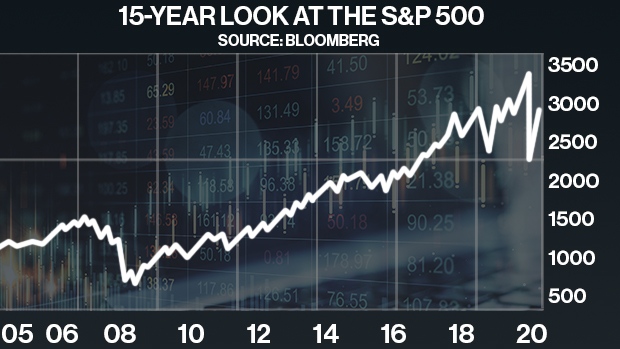May 1, 2020
Ease portfolio panic by taking a five-year view
By Dale Jackson

Sign up for BNN Bloomberg's new weekly newsletter, Home Economics, which aims to help Canadians navigate their personal finances in the age of social distancing and beyond. Have it delivered to your inbox every Friday by subscribing at https://www.bnnbloomberg.ca/subscribe
Until we know the full impact of COVID-19 on the global economy, determining where equity markets are heading is anybody’s guess. That’s causing a lot of anxiety for retail investors helplessly watching their retirement savings flapping in gale-force winds.
It might be hard to imagine a point in the future when things get back to normal – whatever that may be – but a five-year view could help put your long-term financial goals in perspective.
Five years is the standard benchmark to measure investment progress because it’s short enough to better anticipate the future and long enough to smooth out the blips.
Calling a global pandemic a blip might seem callous, but past market panics provide insight into the consistency of how they play out in five-year increments.
The most recent comparable panic was the market meltdown resulting from the 2008 global financial crisis. The catalysts were different, but the panic then was similar to the pandemic reaction we’re seeing now, and just about any other market crisis.
- As cash flows run dry, here are three sources that can provide Canadians relief
- Looking for 'buy' signals in the latest round of corporate earnings
- Mass migration to home offices brings tax perks
READ MORE FROM 'PAYBACK TIME'
To make the point: suppose you loaded up your portfolio with a diversified range of stocks similar to the weightings on the S&P 500 on August 4, 2008. That was the cliff for the S&P 500 before the meltdown.
By March 9, 2009 – seven months later – your portfolio would have lost 40 per cent of its value. On that late winter day it must have seemed like the world was ending for many investors. And the only thing to do was sell everything before their portfolios completely evaporated.
But if you backed away from the sell button and took the five year view, by August 4, 2012 that portfolio of equities purchased five years earlier had gained in value by 30 per cent.
Averaged out over five years, your portfolio would have returned over five per cent annually during the worst of a market meltdown at the time. A blip in retrospect.
Fast forward to February 10, 2020 just before the S&P 500 fell off the COVID-19 cliff. If you loaded up your portfolio that day, by March 16 it would have lost 32 per cent of its value in just over a month.
Now, less than three months after February 10, the S&P 500 is only 13 per cent below the COVID cliff and there is still four years and nine months left in your five-year plan.

It’s impossible to know where equity markets go from here, or if they’ll even fall below the March 16 low. But if history is any indication, they have always gone up over the long-term.
As always, the key to riding the upward trajectory is diversification. Your portfolio should look similar to the S&P 500 because it is the best reflection of the global stock market. If it looks like the TSX Composite index it is too heavily weighted toward resource and financial stocks.
Diversification also includes a weighting in fixed-income, which produces returns regardless of equity market performance, cushions your portfolio from volatility, and provides income to weather out market downturns such as this.
Creating a diversified portfolio is no easy task, and is best left to a qualified investment advisor – provided fees don’t impede performance.
It’s hard to know the human psychology when personal financial security is at stake. Perhaps it’s an all-or-nothing casino mentality that only achieves gratification from big gains in short periods of time – like a baseball player who either hits a home run or is called out.
Here’s food for thought: A seven-per-cent annual return will double your investments in in two-to-five-year plans. If you make contributions along the way, they could double in one five-year plan.
You can’t hit a home run every time, but a few good singles will still get you home.
Payback Time is a weekly column by personal finance columnist Dale Jackson about how to prepare your finances for retirement. Have a question you want answered? Email dalejackson.paybacktime@gmail.com.









